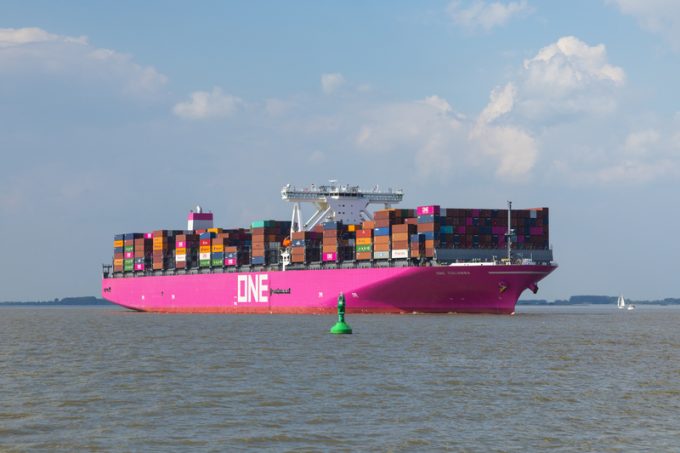Red Sea crisis dictates container fleet capacity trends
As anticipated, containership deployment trends in the first half of 2024 have been dictated by ...
TFII: SOLID AS USUALMAERSK: WEAKENINGF: FALLING OFF A CLIFFAAPL: 'BOTTLENECK IN MAINLAND CHINA'AAPL: CHINA TRENDSDHL: GROWTH CAPEXR: ANOTHER SOLID DELIVERYMFT: HERE COMES THE FALLDSV: LOOK AT SCHENKER PERFORMANCEUPS: A WAVE OF DOWNGRADES DSV: BARGAIN BINKNX: EARNINGS OUTODFL: RISING AND FALLING AND THEN RISING
TFII: SOLID AS USUALMAERSK: WEAKENINGF: FALLING OFF A CLIFFAAPL: 'BOTTLENECK IN MAINLAND CHINA'AAPL: CHINA TRENDSDHL: GROWTH CAPEXR: ANOTHER SOLID DELIVERYMFT: HERE COMES THE FALLDSV: LOOK AT SCHENKER PERFORMANCEUPS: A WAVE OF DOWNGRADES DSV: BARGAIN BINKNX: EARNINGS OUTODFL: RISING AND FALLING AND THEN RISING

Topsy-turvy markets over the past three years have seen freight rates see-saw wildly, caused by supply chain congestion, and that had the effect of raising charter rates and extending charter periods.
Base charter rate levels have remained higher than the pre-pandemic period, even as some charterers have re-negotiated deals, as extended time charters persist, maintaining the low number of available ships.
More recently the whiplash-inducing falls in containership markets over the latter part of 2022 have settled over the course of the first quarter. While the declines in spot freight rates have slowed, timecharter rates are beginning to see modest upward movement.
That will add to the upward pressure on contract and spot rate levels.
In its Q1 23 container market report, MSI notes that while January and February saw further downward revisions to assessed earnings of the larger, 5,500 teu benchmarks, by the middle of March, assessed earnings for smaller benchmarks had started to tick upwards again. While far, far below, where rates sat at the end of August 2022, prevailing market levels remain healthy by pre-2020 standards.
A notable lull in market activity around the middle of February, following the lunar new year, was bookended by swifter fixing activity at the start of the year and over the first half of March. Average fixture durations have crept back upwards from the end of 2022, when shorter durations were largely only available.
While interest from liner operators continues to ebb and flow, with certain smaller operators in particular taking the fall in rates as an opportunity to re-enter the market, after being effectively locked out during the boom, the dominant dynamic that continues to impact the charter market remains the shortage of vessels available to hire.
While forward availability of tonnage has improved relative to the position six months ago, according to the market, it still remains far below historical average levels. There is also still very little available to hire on a spot basis, with a recent increase in the containership idle fleet to above 3% of the total fleet being almost entirely driven by idling of liner-owned tonnage (see Chart 1 below).
So, following what was a surprisingly swift end to the industry’s recent boom period, the market now finds itself apparently far more settled. The question is whether this current market situation represents a sustainable equilibrium over the quarters to come.
Our judgement is that the freight and time-charter markets are increasingly ‘out of line’, although the divergence is less obvious if wider contract market average revenues are used to measure freight market conditions rather than spot market measures. We do expect the difference between contract and spot freight rates will narrow over the next several quarters, but for now, wider average liner unit revenues have not returned all the way back to pre-2020 standards.
Assuming this does happen, or at least wider average rates fall to a level circa 10%-15% above pre-2020 averages, at that stage we would consider current charter market conditions to be unsustainably strong.
It is sometimes put to us, however, that even if overall fleet growth is set to be unusually strong in the coming years, the pool of charter market vessels available to liner companies will not necessarily grow and, even in weak market conditions, lines will still need to add vessels to their networks.
The structure of the orderbook, of course, has a number of odd features as concerns the charter market. While orderbook-fleet ratios for smaller benchmarks are not insignificant (the ratio for sub-3,900 teu assets was just over 16% at the end of February, down from a recent peak of 19% but still above any level seen since 2008), they, of course, are set against increasingly elderly fleets, and especially after the recent two-year scrapping hiatus allowed average ages to creep upwards again.
Chart 2 (above) plots the count of vessels due to be delivered in 2023 in each size band (differentiating vessels with liner owners/known charterers and those without), and compares those deliveries to the size of the existing charter market fleet and the proportion of the fleet above 20 years old.
While new deliveries in 2023 are scheduled to be equivalent to more than 20% of the current charter market fleet in the 1,300-3,900 teu segment, the share of vessels above 20 years old is even higher. A similar picture appears in the 5,200-7,600 teu segment. To us, this suggests the potential for high scrapping to prevent much incremental growth in charter market fleets in the next several years.
While the coming years are going to be complicated, in terms of a disconnect between growth in the overall teu capacity of the fleet and growth in the number of charter market vessels, our overall position and assumption, as a fundamentals-based forecaster, is that a period of general oversupply in the market will produce weak market conditions across the board.
So while we expect that T/C rates will climb further over the remainder of Q1 and into Q2, over H2 2023, and the first half of 2024 we forecast T/C rates will return to ‘normal/average’ pre-2020 levels, with additional downside risks.
Comment on this article